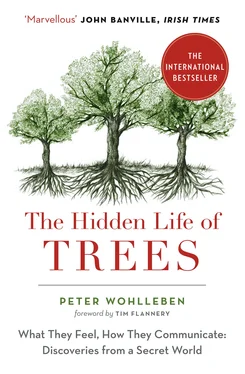The reason for this behavior is astonishing. The acacia trees that were being eaten gave off a warning gas (specifically, ethylene) that signaled to neighboring trees of the same species that a crisis was at hand. Right away, all the forewarned trees also pumped toxins into their leaves to prepare themselves. The giraffes were wise to this game and therefore moved farther away to a part of the savannah where they could find trees that were oblivious to what was going on. Or else they moved upwind. For the scent messages are carried to nearby trees on the breeze, and if the animals walked upwind, they could find acacias close by that had no idea the giraffes were there.
Similar processes are at work in our forests here at home. Beeches, spruce, and oaks all register pain as soon as some creature starts nibbling on them. When a caterpillar takes a hearty bite out of a leaf, the tissue around the site of the damage changes. In addition, the leaf tissue sends out electrical signals, just as human tissue does when it is hurt. However, the signal is not transmitted in milliseconds, as human signals are; instead, the plant signal travels at the slow speed of a third of an inch per minute. 4Accordingly, it takes an hour or so before defensive compounds reach the leaves to spoil the pest’s meal. Trees live their lives in the really slow lane, even when they are in danger. But this slow tempo doesn’t mean that a tree is not on top of what is happening in different parts of its structure. If the roots find themselves in trouble, this information is broadcast throughout the tree, which can trigger the leaves to release scent compounds. And not just any old scent compounds, but compounds that are specifically formulated for the task at hand.
This ability to produce different compounds is another feature that helps trees fend off attack for a while. When it comes to some species of insects, trees can accurately identify which bad guys they are up against. The saliva of each species is different, and trees can match the saliva to the insect. Indeed, the match can be so precise that trees can release pheromones that summon specific beneficial predators. The beneficial predators help trees by eagerly devouring the insects that are bothering them. For example, elms and pines call on small parasitic wasps that lay their eggs inside leaf-eating caterpillars. 5As the wasp larvae develop, they devour the larger caterpillars bit by bit from the inside out. Not a nice way to die. The result, however, is that the trees are saved from bothersome pests and can keep growing with no further damage. The fact trees can recognize saliva is, incidentally, evidence for yet another skill they must have. For if they can identify saliva, they must also have a sense of taste.
A drawback of scent compounds is that they disperse quickly in the air. Often they can be detected only within a range of about 100 yards. Quick dispersal, however, also has advantages. As the transmission of signals inside the tree is very slow, a tree can cover long distances much more quickly through the air if it wants to warn distant parts of its own structure that danger lurks. A specialized distress call is not always necessary when a tree needs to mount a defense against insects. The animal world simply registers the tree’s basic chemical alarm call. It then knows some kind of attack is taking place and predatory species should mobilize. Whoever is hungry for the kinds of critters that attack trees just can’t stay away.
Trees can also mount their own defense. Oaks, for example, carry bitter, toxic tannins in their bark and leaves. These either kill chewing insects outright or at least affect the leaves’ taste to such an extent that instead of being deliciously crunchy, they become biliously bitter. Willows produce the defensive compound salicylic acid, which works in much the same way. But not on us. Salicylic acid is a precursor of aspirin, and tea made from willow bark can relieve headaches and bring down fevers. Such defense mechanisms, of course, take time. Therefore, a combined approach is crucially important for arboreal early-warning systems.
Trees don’t rely exclusively on dispersal in the air, for if they did, some neighbors would not get wind of the danger. Dr. Suzanne Simard of the University of British Columbia in Vancouver has discovered that they also warn each other using chemical signals sent through the fungal networks around their root tips, which operate no matter what the weather. 6Surprisingly, news bulletins are sent via the roots not only by means of chemical compounds but also by means of electrical impulses that travel at the speed of a third of an inch per second. In comparison with our bodies, it is, admittedly, extremely slow. However, there are species in the animal kingdom, such as jellyfish and worms, whose nervous systems conduct impulses at a similar speed. 7Once the latest news has been broadcast, all oaks in the area promptly pump tannins through their veins.
Tree roots extend a long way, more than twice the spread of the crown. So the root systems of neighboring trees inevitably intersect and grow into one another—though there are always some exceptions. Even in a forest, there are loners, would-be hermits who want little to do with others. Can such antisocial trees block alarm calls simply by not participating? Luckily, they can’t. For usually there are fungi present that act as intermediaries to guarantee quick dissemination of news. These fungi operate like fiber-optic Internet cables. Their thin filaments penetrate the ground, weaving through it in almost unbelievable density. One teaspoon of forest soil contains many miles of these “hyphae.” 8Over centuries, a single fungus can cover many square miles and network an entire forest. The fungal connections transmit signals from one tree to the next, helping the trees exchange news about insects, drought, and other dangers. Science has adopted a term first coined by the journal Nature for Dr. Simard’s discovery of the “wood wide web” pervading our forests. 9What and how much information is exchanged are subjects we have only just begun to research. For instance, Simard discovered that different tree species are in contact with one another, even when they regard each other as competitors. 10And the fungi are pursuing their own agendas and appear to be very much in favor of conciliation and equitable distribution of information and resources. 11
If trees are weakened, it could be that they lose their conversational skills along with their ability to defend themselves. Otherwise, it’s difficult to explain why insect pests specifically seek out trees whose health is already compromised. It’s conceivable that to do this, insects listen to trees’ urgent chemical warnings and then test trees that don’t pass the message on by taking a bite out of their leaves or bark. A tree’s silence could be because of a serious illness or, perhaps, the loss of its fungal network, which would leave the tree completely cut off from the latest news. The tree no longer registers approaching disaster, and the doors are open for the caterpillar and beetle buffet. The loners I just mentioned are similarly susceptible—they might look healthy, but they have no idea what is going on around them.
In the symbiotic community of the forest, not only trees but also shrubs and grasses—and possibly all plant species—exchange information this way. However, when we step into farm fields, the vegetation becomes very quiet. Thanks to selective breeding, our cultivated plants have, for the most part, lost their ability to communicate above or below ground. Isolated by their silence, they are easy prey for insect pests. 12That is one reason why modern agriculture uses so many pesticides. Perhaps farmers can learn from the forests and breed a little more wildness back into their grain and potatoes so that they’ll be more talkative in the future.
Читать дальше












